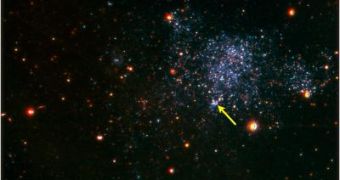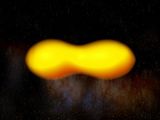Astronomers from the Ohio State University reveal that they have discovered two new star systems which present particularities that associate them to a rare type of supernova. While studying a unique star system 13 million years away from Earth, hidden inside Holmberg IX, a small galaxy orbiting the M81 galaxy, researchers discovered a second star system that appeared to be much closer than the first one.
Observations were conducted with the help of the Large Binocular Telescope located on Mountain Graham in Arizona, from January to October 2007. These types of star systems are known to astronomers as 'yellow supergiant eclipsing binaries', because they contain two bright yellow stars orbiting each other from a very close distance. This configuration enables them to experience powerful gravitational interactions, so that they actually exchange material between each other, thus giving the system the appearance of a peanut.
As they orbit each other, from time to time one of the two stars moves in front of the other to eclipse it, making the system appear less bright than it really is. According to the study published by astronomers from Ohio State University, the two stars are almost identical, having masses equivalent to 15 times that of the Sun, and respectively 20 solar masses.
Graduate student and lead author of the study Jose Prieto, from Ohio State University, analyzed the star system in the Holmberg IX galaxy in order to establish whether this was the first 'yellow supergiant eclipsing binary' discovered by the researching team. Nonetheless, he soon realized that another such binary system existed only 230,000 light years away in the Small Magellanic Cloud, a small galaxy orbiting around the Milky Way.
Although it was detected almost three decades ago, it had been incorrectly catalogued at the time and remained like that until now. Further analysis revealed that the patterns of light emitted by the two star systems are relatively similar, thus the star systems have been identical. In addition, the two stars in the latest discovered binary are believed to have masses close to those of the first system, respectively 15 and 20 solar masses and might exchange material, giving it the shape of a peanut as well.
"We didn't expect to find one of these things, much less two. You never expect this sort of thing. But I think this shows how flexible you have to be in astrophysics. We needed the 8.4 meter LBT to stop the first binary. Yet, if we hadn't found the first one, we may never have found the second one," says associate professor of astronomy at Ohio State University, Kris Stanek. "It shows that there are still valuable discoveries hidden in plain sight. You just have to keep you eyes open and connect the dots."
Connection with rare supernova type
Prieto says that, of all the supernovae that have been studied in the last few years, only two seem to have some connection to supergiant yellow stars. In a few million years, astronomers can expect two more, in the form of the binaries recently discovered. Usually, massive stars oscillate between two states - cool red giant and hot blue stars, but spend very little time between these states, when they experience a yellow, intermediate state.
The vast majority of stars end their lives in a red giant, while just a few may end up blue; however, a star never ends its life in a yellow state. Until now at least. These two binary systems discovered at the Ohio State University may just be the progenitors for the supergiant yellow stars supernovae. "When two stars orbit each other very closely, they share material, and the evolution of one affects the other. It's possible two supergiants in such a system would evolve more slowly, and spend more time in the yellow phase - long enough that one of them could explode as a yellow supergiant," said Prieto.

 14 DAY TRIAL //
14 DAY TRIAL // 
